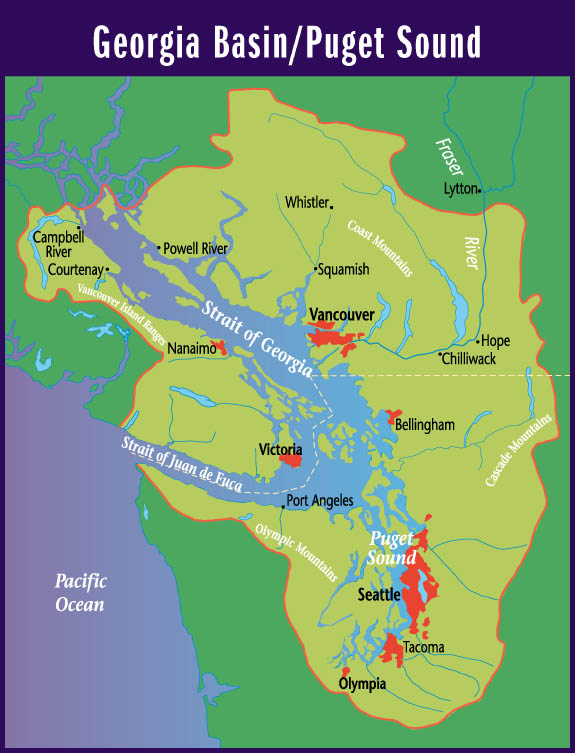
 |
Suggested Locations for the Placement of Environment Canada's New Hydrometric Stations in the Georgia Basin |
| Title Page |
| Introduction |
| Data |
| Methodology |
| Spatial Analysis |
| Problems & Errors |
| Conclusion |
METHODOLOGY
To develop locations for Environment Canada's new hydrometric stations, I had to consider several criteria. They are as follows:
1) Available
transportation to reach potentially remote hydrometric stations.
2) Hydrologic
zonation.
3) Stream
orders of watersheds.
4) Location
of streams. (Of course!)
For my multicriteria analysis,
I gave each of my final coverages non-boolean standardization with the
exception of one constraint.
1. Transportation
There are two methods of transportation to reach hydrometric stations that are situated on rivers and streams. One is by roads, naturally, and the second, according to my old co-op supervisor, Paul Whitfield, is by helicopter.
Helicopter Landing Sites
One of the most important criteria for selecting a helicopter landing site is the slope of the land. Canadian Helicopters informed me that a helicopter could land in a tree-covered area at a 10 degree slope, provided that its nose was uphill (1). Other sources (2) also suggest that 10 degrees is the maximum slope typically tolerated by a helicopter.
From my DEM, I did a slope analysis, in degrees, of the Georgia Basin, using the module SURFACE. Figure 14 shows this result. I then used FUZZY, selecting a monotonically decreasing sigmoidal curve, where slopes in the range of 0 to 10 degrees were ranked best while slopes greater than 10 degrees were deemed to be unsuitable. I called this coverage SLOPESFUZZ.
Since streams often lie in flat valleys, (shallow slope), I couldn't have a helicopter landing site stretched across a stream! I RECLASSed my ALLSTREAMS coverage to STREAMSZERO, where, as it sounds, drainage had a value of 0 and all other regions a value of 1. Similarly, I noticed that areas where there were lakes appeared to be flat, acceptable regions on my map. I brought in 15 lakes coverages from ArcView, (in a manner virtually identical to that described in the Streams Coverage section, in Data), to IDRISI. I created a single large LAKES coverage which was RECLASSed to LAKESZERO. I OVERLAYed these two water coverages to produce NOWATER. Then I OVERLAYed this coverage with SLOPESFUZZ to produce SLOPESFUZZDRY.
However, SLOPESFUZZDRY contained the the Georgia Strait in its coverage. To eliminate this, I had to create a coverage called LAND which was the CONCATenation of all of the raster watershed images I had produced previously. ("WATERSHEDs" in the cartographic model under the Watersheds Coverage, in Data). Using a raster mask of the boundary of the Georgia Basin, I OVERLAYed these two to produce a raster coverage of land strictly within the boundary of this analysis, GBLAND. I then RECLASSed this image such that all land had a value of 1 and all water a value of 0. I now OVERLAYed this image with SLOPESFUZZDRY to eliminate the Strait from the coverage (HELIGOOD).
Click here to see the cartographic model of this process.
According to Canadian Helicopters (1) and other sources, a suitable helicopter landing site is 100 ft by 100 ft (approximately 925 m2). I attempted to find suitable areas that met this criteria. Since my coverage was so big and it contained so many areas, I had to first use WINDOW to painstakingly break the image up into 16 pieces. To make a long story short, after GROUPing and CONCATenating the thing back together, when I used AREA, I remembered that the smallest unit of area in the image - a pixel - was 2500 m2 ! (Duh!) Thus, all areas met the requirement and my three hours of work had been for nothing! (Sigh...)
Thus, HELIGOOD is my final
coverage of suitable helicopter landing sites with the shallowest slopes
having the highest ratings.
Proximity to Roads
Another criteria that is important in considering new locations for Environment Canada's hydrometric stations is their proximity to roads. That is, station locations that can be easily accessed by roads are more desirable than those that cannot. Also, station locations that are closer to major routes are preferred to those that are only accessible by inferior/more difficult routes.
My transportation network coverage contained different types of roads each identified by a special code. I created a large Attribute Values file (over 24,000 lines!) whereby I ASSIGNed each road a value according to its place in the hierarchy. For example, paved roads are preferred to travel by than gravel roads. I based my ranking on the descriptions given in the table as well as by performing queries on the vector image in IDRISI, to visually identify what sort of roads they were. Ferry routes, railways, tunnels, and electrical lines received a value of zero. See Table 2 for the road rankings. I then OVERLAYed this image with a raster mask of the Georgia Basin to mask out roads outside it. ROADRANKS2 is the result.
Click here
to see the cartographic model of this process.
 |